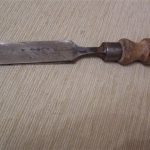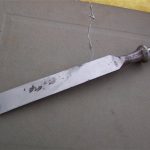We may receive a commission when you use our affiliate links. However, this does not impact our recommendations.

“When newspaper reporters write about this school, some of them write, ‘And he builds chairs without using nails!’ That’s like saying: ‘And he builds automobiles without using hamburger.'”
– Michael Dunbar, May 20, 2010
During my week at The Windsor Institute in Hampton, N.H., I’ve gotten a lot of questions from readers of the blog about the school, their equipment, their teaching methods and if my father is willing to switch teams (he’s not).
Instead of answering every question individually, I’m going to be hyper-lazy and do it here on the blog. Here we go.
What, no shavehorses?
Indeed, all the shaping operations for the chairs built at The Windsor Institute are made at a joiner’s-style workbench with a quick-release end vise. Now, it’s not my intent to open a full scale War of the Horses here, I do have the gumption to say the following. I own a shaving horse, a shaving pony (a device that clamps into a vise) and multiple quick-release vises.
All of the workholding systems work really well. In fact, I was surprised how much I liked working my spindles in a quick-release vise. And the bonus is, of course, that you don’t have to build a shaving horse and you don’t have to store it (which is a real problem for me. Those suckers are big.)
But isn’t it slower than a shavehorse? Maybe it is a little slower when shaping spindles. But I think you make up for that time when you need to shape your arms and bows. The quick-release vise is worlds better and faster than a shaving horse for this in my opinion.
The bottom line here is all the systems work. And if you are worried about the ghosts of chairmakers coming down and haunting you because you are using a quick-release vise, fear not. Michael Dunbar showed me early engravings of chairmakers in enclosed shops using joiner’s vises. So all the vises are good vises.
What, You Didn’t Turn the Legs and Stretcher?
No, we didn’t turn the legs or the stretcher. Those were supplied by the school. And there’s ample evidence that lots of chairmakers worked the same way. It was economical to buy the turned parts from a turner who did that task alone. Lots of early woodworking businesses were segmented this way, especially in urban areas. There would be turners, carvers, finishers, gilders, etc.
I’ve turned my legs and stretchers during two other chair classes. I enjoyed the process. But turning is a different skill than chairmaking. And The Windsor Institute is a chairmaking school.
Why Did You Choose The Windsor Institute?
Dunbar has long been one of my heroes, even before I met him and brought him on as a writer at this magazine. What’s unique about this school is that it is , more than anything , a complete support group for chairmakers. In addition to classes, the school sells high-quality supplies and specialized tools. They offer marketing and business advice for budding entrepreneurs. And, most of all, the focus is on teaching the craft in a way that can be easily replicated in your shop immediately when you get home.
Dunbar, his staff and students have refined the process of making a chair to the point where if you pay attention and take some care, you can build a chair. Their specialty is debunking the process. Ever single compound angle and wild tapered joint has a simple solution. My forehead is still a tad red from slapping it so many times when a new trick was revealed.
And I’ve built about 10 stick chairs already, so I think that’s saying something.
By the way, I’m sure some of you are wondering this, so I’ll write it out. I paid full price for my class (and my father’s class). I paid for my own travel. Paid for my lodging and food (except for one Allagash beer). And it was out of my pocket, not the magazine’s.
And one more thing: I’m already making plans to go back. The only thing standing in my way is figuring out which style of chair to build next.
– Christopher Schwarz
Other Chairmaking Books I Recommend
– “Traditional Windsor Chairmaking” by Jim Rendi
– “Chairmaking Simplified” by Kerry Pierce
– “The Chairmaker’s Workshop” by Drew Langsner
– “Windsor Chairmaking” by James Murcell
– “Welsh Stick Chairs” by John Brown

Here are some supplies and tools we find essential in our everyday work around the shop. We may receive a commission from sales referred by our links; however, we have carefully selected these products for their usefulness and quality.









Regarding turning…lest there be any question Mike Dunbar is one heck of a turner…fast and accurate. I spent one wonderful summer working at the Institute a while back, and saw him turn spindles and tapers that would always fit and it seemed he just eyeballed it. Tell him I admire his svelte figure.
Dan
Ah bodgers, people who made a living by coppicing wood and then creating something with a commercial value from what they harvested. In mnay areas of the UK, this used to mean turning spindles, legs, etc and supplying them to local chairmakers.
"I’m already making plans to go back."
Perhaps another Knight of Windosor in the making?
Chris, I think I enjoy your blog almost as much as the magazine. Keep up the good work and see you in October.
Martin,
It wasn’t a class on tool set up. I brought my own tools sharpened the way I like them. As did the other students. However, the school has tons of tools that are sharp and ready to go. So you can try their tools and see what you think. During the downtime you can ask about sharpening or whatever.
So you don’t have to alter any of your tools to build a chair.
Chris
Chris,
Mike mentions on his website that drawknives should be sharpened "like a knife" while other chairmakers say to sharpen it "like a chisel". Can you please explain Mike’s reasoning for the "like a knife" comment? Does it really matter? I have considered taking a clase there, but I don’t want to ruin a good drawknife for an instructor’s preference.
Here’s a really dumb question. How are you getting your chair home? It’s you, your Dad, and John if I recall. That’s three people with three chairs. Sounds like a cramped car ride or very interesting looks at the luggage check in at the airport.